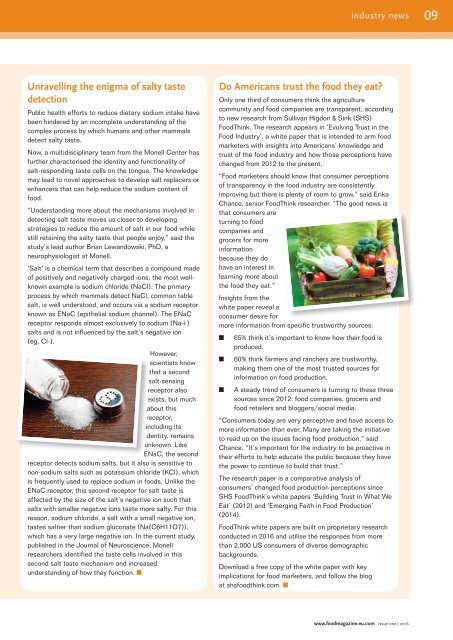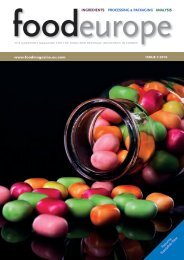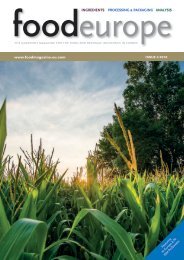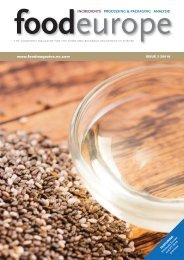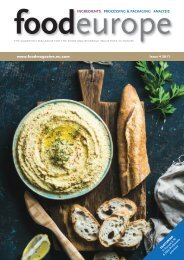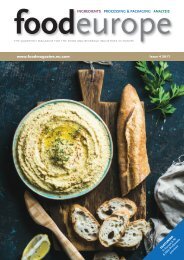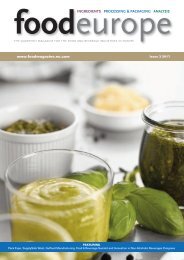Issue_1_2016
Create successful ePaper yourself
Turn your PDF publications into a flip-book with our unique Google optimized e-Paper software.
industry news<br />
09<br />
Unravelling the enigma of salty taste<br />
detection<br />
Public health efforts to reduce dietary sodium intake have<br />
been hindered by an incomplete understanding of the<br />
complex process by which humans and other mammals<br />
detect salty taste.<br />
Now, a multidisciplinary team from the Monell Center has<br />
further characterised the identity and functionality of<br />
salt-responding taste cells on the tongue. The knowledge<br />
may lead to novel approaches to develop salt replacers or<br />
enhancers that can help reduce the sodium content of<br />
food.<br />
“Understanding more about the mechanisms involved in<br />
detecting salt taste moves us closer to developing<br />
strategies to reduce the amount of salt in our food while<br />
still retaining the salty taste that people enjoy,” said the<br />
study’s lead author Brian Lewandowski, PhD, a<br />
neurophysiologist at Monell.<br />
‘Salt’ is a chemical term that describes a compound made<br />
of positively and negatively charged ions; the most wellknown<br />
example is sodium chloride (NaCl). The primary<br />
process by which mammals detect NaCl, common table<br />
salt, is well understood, and occurs via a sodium receptor<br />
known as ENaC (epithelial sodium channel). The ENaC<br />
receptor responds almost exclusively to sodium (Na+)<br />
salts and is not influenced by the salt’s negative ion<br />
(eg, Cl-).<br />
However,<br />
scientists know<br />
that a second<br />
salt-sensing<br />
receptor also<br />
exists, but much<br />
about this<br />
receptor,<br />
including its<br />
identity, remains<br />
unknown. Like<br />
ENaC, the second<br />
receptor detects sodium salts, but it also is sensitive to<br />
non-sodium salts such as potassium chloride (KCl), which<br />
is frequently used to replace sodium in foods. Unlike the<br />
ENaC receptor, this second receptor for salt taste is<br />
affected by the size of the salt’s negative ion such that<br />
salts with smaller negative ions taste more salty. For this<br />
reason, sodium chloride, a salt with a small negative ion,<br />
tastes saltier than sodium gluconate (Na(C6H11O7)),<br />
which has a very large negative ion. In the current study,<br />
published in the Journal of Neuroscience, Monell<br />
researchers identified the taste cells involved in this<br />
second salt taste mechanism and increased<br />
understanding of how they function. n<br />
Do Americans trust the food they eat?<br />
Only one third of consumers think the agriculture<br />
community and food companies are transparent, according<br />
to new research from Sullivan Higdon & Sink (SHS)<br />
FoodThink. The research appears in ‘Evolving Trust in the<br />
Food Industry’, a white paper that is intended to arm food<br />
marketers with insights into Americans’ knowledge and<br />
trust of the food industry and how those perceptions have<br />
changed from 2012 to the present.<br />
“Food marketers should know that consumer perceptions<br />
of transparency in the food industry are consistently<br />
improving but there is plenty of room to grow,” said Erika<br />
Chance, senior FoodThink researcher. “The good news is<br />
that consumers are<br />
turning to food<br />
companies and<br />
grocers for more<br />
information<br />
because they do<br />
have an interest in<br />
learning more about<br />
the food they eat.”<br />
Insights from the<br />
white paper reveal a<br />
consumer desire for<br />
more information from specific trustworthy sources:<br />
n<br />
n<br />
65% think it’s important to know how their food is<br />
produced.<br />
60% think farmers and ranchers are trustworthy,<br />
making them one of the most trusted sources for<br />
information on food production.<br />
n A steady trend of consumers is turning to these three<br />
sources since 2012: food companies, grocers and<br />
food retailers and bloggers/social media.<br />
“Consumers today are very perceptive and have access to<br />
more information than ever. Many are taking the initiative<br />
to read up on the issues facing food production,” said<br />
Chance. “It’s important for the industry to be proactive in<br />
their efforts to help educate the public because they have<br />
the power to continue to build that trust.”<br />
The research paper is a comparative analysis of<br />
consumers’ changed food production perceptions since<br />
SHS FoodThink’s white papers ‘Building Trust in What We<br />
Eat’ (2012) and ‘Emerging Faith in Food Production’<br />
(2014).<br />
FoodThink white papers are built on proprietary research<br />
conducted in <strong>2016</strong> and utilise the responses from more<br />
than 2,000 US consumers of diverse demographic<br />
backgrounds.<br />
Download a free copy of the white paper with key<br />
implications for food marketers, and follow the blog<br />
at shsfoodthink.com. n<br />
www.foodmagazine.eu.com issue one | <strong>2016</strong>


